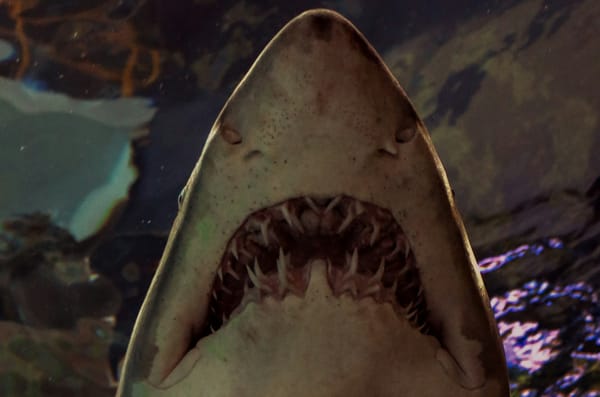The Frog Pond #16: Satellite Killer
Move over Bermuda Triangle, there's a bigger Atlantic anomaly and it's killing satellites.

Move over Bermuda Triangle, there's a bigger Atlantic anomaly and it's killing satellites.
The Earth's "pothole" in space
The South Atlantic Anomaly (SAA), nicknamed the "pothole in space", is a large area over the centre of South America, across the south portion of the Atlantic Ocean, to the top of South Africa. It has a high concentration of high radiation close to the Earth's surface due to a very weak geomagnetic field there1. Basically, radiation from the sun can reach this area easier because the Earth's magnetic field is so weak there.
The SAA isn't new, as its been present during the entire 400 year history of humanity's ability to study the Earth's magnetic field1. It wasn't always such a variable area though, as models have shown a quiet period in the mid-to-late Holocene period (about 8,200 - 4,200 year ago)2. Researchers are able to put together a picture of Earth's magnetic field by studying archeological artifacts, volcanic rocks, and sediments. These materials keep a thermal-magnetic remanence that show a "spot read" of the magnetic field's intensity and directional data to create a long-term model2, though this method isn't foolproof since environmental and chemical factors can change these readings over time2. A lot of data from a wide variety of locations and materials is necessary to get a full picture.
The SAA's size has changed over the last 70 years since its discovery in 1958. There's been an expansion of its northwest, north, northeast, and east borders3. It may also be splitting into two smaller regions as of 20204.
The magnetic weakness isn't life-threatening to anything on Earth, but it creates a lot of complications when launching anything into low orbit4. This area of high radiation and weak magnetism can cause big issues for satellites and spacecraft that orbit Earth, exposing them to much stronger ionizing radiation, where these ionized protons from the sun are trapped in the area due to the low repulsion relative to the rest of Earth's magnetic field5, when they'd normally be bounced back and forth from pole to pole by the Earth's donut-shaped radiation belts4. Exposure can lead to onboard computer failure and data collection interference5.
What causes the weak magnetism?
To find the most likely cause, we need to look inward—very inward. Earth's magnetic field's biggest factor is the molten metal in the outer core of the planet. A location called the "African Large Low Shear Velocity Province" (LLVP or superplume) disrupts the metal's flow, weakening the magnetic field overall4.
These superplumes (both the African one impacting the SAA and a Pacific one) extend out from the mantle towards the crust of the earth up to 1,000 km and make up about 6% of Earth's volume7.
Superplumes are hypothesized to be formed by the accumulation of "subducted oceanic slabs", or graveyard slabs, a process where Earth's surface crust can be recycled into the mantle by erosion or delamination (sinking)7. These slabs could be fuel for the superplume.
Another origin proposed is the "giant-impact hypothesis" involving the Moon's formation from Earth's collision with a planet-sized body, where the superplumes could be fragments of the other planet's mantle that sank within the Earth's core8.
Either way, the superplumes aren't going anywhere any time soon.
How do we manage satellites over the SAA?
Degradation of electronic components by radiation damage is the main problem for satellites. Globalstar, a phone and data comms company, lost multiple satellites in 2007 to degradation9.
The Japan Aerospace Exploration Agency's (JAXA) X-ray Astronomy Satellite, or Hitomi, was launched into low-orbit in 2016 to study high-energy X-rays in space. Hitomi experienced problems while flying through the SAA and its systems may have been damaged by the radiation. March of the same year, JAXA lost all contact with the probe and later learned it had spun out of control, broken up, and fallen out of orbit9.
While the International Space Station, Skylab, and SpaceX's Dragon have radiation shielding to protect the astronauts and equipment inside, they've all experienced glitches while passing through the SAA9. Spacewalks are planned not to take place while crossing the SAA9.
The current solutions for satellites is simple. When passing through the SAA, they usually power down before they enter the region to avoid frying the electronics4. Hardier tech, stronger shielding, and strategic placement of electronics in spacecraft can also help avoid hazards in the SAA9.
Does the SAA mean we're losing our magnetic field?
Good news: No!
Some researchers believe the SAA indicates that the Earth's magnetic field could flip polarizations, which would cause havoc for our electronics systems, but would take 100,000s of years to happen4. A 2020 paper concluded that the SAA is a reoccurring phenomenon dating back 11 million years and won't lead to any long-term consequences for us on the planet4.
If you enjoy my monthly deep dives, please consider sharing this post with a friend!
A word from a passing frog
On February 16, I rushed to the hospital to sit vigil at my maternal grandmother's side alongside other close family. She died a week later, still always in family company in palliative care, and I'm so thankful for our time together.
Writing, reading, basically anything productive flew out the window as time paused for that week with her. By the time this newsletter goes out, I'll be attending her funeral in her hometown. She had a full life as a medical lab tech (when few women were!), mother, girl guides leader, long-term care advocate, dog lover, and grandmother.
You'll understand that I didn't get a ton done—and thank you so much to the many writing friends who have been so lovely and supportive this month.
Writing
I'm officially on submission with my maritime gothic horror novel, affectionately nicknamed Lighthouse book. I'm lucky to know some writers either currently "on sub" or who have gone through the process before, so it's been a great experience learning from them about what to expect. I'm heading into it the same as I approached querying - hoping for the best and expecting nothing!
I'm beyond proud of how much work and love I put into this book, so please cross your fingers for editors to enjoy it as much as I enjoyed writing it!
As for what I'm writing next - honestly, I don't know yet! I've got some projects already in the works from the last few years and a few more that are only ideas at this stage, but given how this month went I'm just trying to be patient with myself for whenever I'll want to start working on my next book.
Reading
February was a much less productive month, reading-wise, but I still enjoyed some great books!
Into The Sunken City by Dinesh Thiru
A climate-fiction novel about two sisters a year after their father's death who want to see the sun, but are stuck in the backwaters of a centuries-flooded America turned archipelago under endless rainclouds. This book features a retelling of Treasure Island, diving, pirates, underwater Las Vegas, and a young woman who'll do anything for her little sister. I loved the voice and the details of the diving scenes!
The Spirit Bares Its Teeth by Andrew Joseph White
An alternate history horror novel set in a world where violet-eyed people can commune with spirits, and the English aristocracy has made the practice illegal for women. The protagonist, a closeted trans boy who wants to be a surgeon, must survive his family's cruelty, a boarding school bent on "fixing" him, and his identity as both trans and autistic in a suffocating society. This book has a lot of uncomfortable elements that White does a great job managing, especially the graphic medical scenes and unflinching dissection of the roots of transphobia. I think it's worth a read if you can handle body horror, but it's not for everyone!
Bonus: 99% Invisible
I haven't listened to this design-focused podcast in forever (probably 6+ years) so I've been slowly catching up on the latest episodes. It's somehow nerdier than NPR and full of anecdotes that, no matter what the subject matter, keep my attention the whole way through. Some recent episodes I highly recommend:
- #570: The White Castle System of Eating Houses
- #555: The Big Dig
- #552: Blood in the Machine
- #550: Melanie Speaks
- #343: The Known Unknown
I also highly recommend some older episodes about numbers stations, how best to warn people in 10,000 years about nuclear waste sites (featuring a folk song!), and how seeds are stored for the apocalypse.
Footnotes
1: https://www.frontiersin.org/articles/10.3389/feart.2016.00040/full
2: https://www.nature.com/articles/s41467-022-28972-8
3: https://www.nytimes.com/1990/06/05/science/dip-on-earth-is-big-trouble-in-space.html
6: https://www.sciencealert.com/nasa-is-tracking-a-huge-growing-anomaly-in-earths-magnetic-field
7: https://ui.adsabs.harvard.edu/abs/2007GondR..11....7M/abstract
8: https://ui.adsabs.harvard.edu/abs/2023Natur.623...95Y/abstract
9: https://www.astronomy.com/space-exploration/the-spacecraft-killing-anomaly-over-the-south-atlantic/





